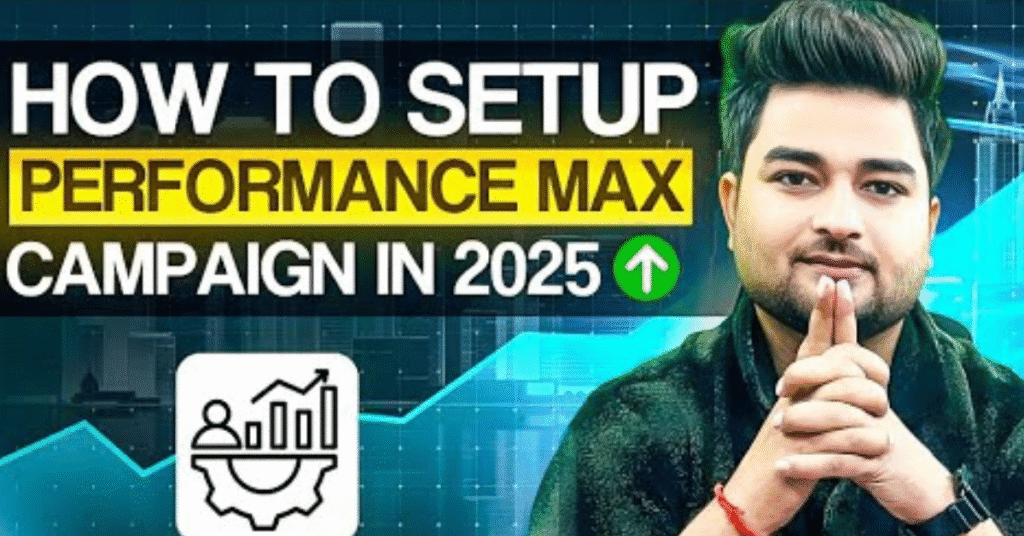Google Ads is constantly evolving — and in 2025, Performance Max (PMax) is the campaign type that every smart marketer is leveraging to dominate multiple ad platforms using automation. Whether you’re a business owner, marketer, or digital agency, understanding how to set up and optimize a Performance Max campaign can be the game-changer for your lead generation strategy.
In this complete guide, we’ll break down step-by-step how to set up a PMax campaign in 2025, plus powerful tips to boost leads and performance.
✅ What is Performance Max Campaign?
Performance Max is a goal-based campaign type by Google Ads that uses automation and machine learning to show your ads across all Google properties:
- Google Search
- YouTube
- Display Network
- Gmail
- Google Maps
- Discover Feed
You provide the creative assets, audience signals, and goals — and Google handles the rest.
💡 Why Use Performance Max in 2025?
- 📈 Maximum reach across all Google channels
- 🤖 Powered by AI and machine learning
- 🎯 Goal-oriented: Lead generation, sales, or traffic
- 📊 Better insights with asset-level performance reports
- 🔥 Smart Bidding + Responsive Ads = High-converting results
🔧 Step-by-Step: How to Setup a Performance Max Campaign in 2025
Step 1: Login to Your Google Ads Account
Go to ads.google.com and sign in.
Step 2: Click “+ New Campaign”
Select the campaign goal:
- Leads
- Sales
- Website traffic
Choose Performance Max as the campaign type.
Step 3: Choose Your Conversion Goals
Make sure your conversion tracking is properly set up (e.g., form fills, purchases, calls). This tells Google what success looks like.
Step 4: Name Your Campaign
Give it a meaningful name (e.g., “Lead Gen – PMax – July 2025”).
Step 5: Set Budget and Bidding Strategy
- Set your daily or monthly budget.
- Choose bidding: Maximize conversions or Maximize conversion value.
- Advanced Tip: Use Target CPA or Target ROAS once you have conversion data.
Step 6: Select Locations and Languages
- Choose your target locations (countries, states, or pin codes).
- Select the language your audience speaks.
Step 7: Add Audience Signals (Very Important in 2025!)
While Google will target broadly, adding audience signals helps speed up learning:
- Custom segments (e.g., “People searching for digital marketing services”)
- Website visitors
- Customer match (email list)
🎯 Pro Tip: Use “purchase intent” keywords in your custom audience signal.
Step 8: Create Your Asset Group (The Heart of PMax)
You’ll need:
- Final URL (landing page)
- Headlines (up to 5)
- Descriptions (up to 5)
- Images (at least 3-5)
- Videos (YouTube link – strongly recommended)
- Logo
- Business name
- Call-to-action (e.g., Learn More, Sign Up)
⚠️ Tip: Use benefit-driven ad copy and high-resolution visuals.
Step 9: Set Up Ad Extensions
Add sitelinks, callouts, phone number, or lead form extensions for better visibility and engagement.
Step 10: Review and Publish
Double-check your settings and click Publish.
Your campaign will go live after Google’s review.
🧠 Performance Max Secrets for More Leads in 2025
✅ 1. Create Multiple Asset Groups
Don’t rely on a single asset group. Create different ones for each service/product to get tailored insights and higher engagement.
✅ 2. Use High-Intent Keywords in Audience Signals
Even though you don’t input keywords directly, using keyword-based audience signals helps Google understand user intent.
✅ 3. Add a Video (Even a Basic One!)
Google gives preference to asset groups with videos. Create a simple 30-second explainer using free tools like Canva or InVideo.
✅ 4. Optimize Landing Pages
Make sure your landing pages are fast, mobile-friendly, and conversion-optimized. Use clear CTAs, trust signals, and forms above the fold.
✅ 5. Track Everything with UTM Parameters
Use UTM tags to track which campaign, asset, or creative is driving results inside Google Analytics 4 (GA4).
📊 How to Measure Success?
- Use Google Ads Insights to track top-performing headlines, images, and videos.
- Monitor conversion value, cost per conversion, and ROAS.
- Check search term insights to see what real users are typing before converting.
🚀 Final Thoughts
Performance Max in 2025 isn’t just a trend — it’s the future of Google Ads. When used correctly, it can massively simplify your campaigns and supercharge your lead generation.
But remember, automation needs strategic input to succeed. Use smart audience signals, high-quality assets, and goal-focused landing pages to help Google’s AI perform at its best.
🔥 Bonus: Tools to Help You Succeed with PMax
- Canva – for ad creative design
- ChatGPT – for generating headline and description variations
- Google Tag Manager – for accurate tracking
- GA4 – for measuring campaign performance
- InVideo / Pictory – for creating quick videos
📌 Frequently Asked Questions (FAQs)
Q1. Is Performance Max good for small businesses?
Yes! It’s beginner-friendly and works well for local lead generation.
Q2. Can I use Performance Max without a video?
You can, but Google will auto-generate a video (not always ideal). It’s better to upload your own.
Q3. How long does it take for PMax to show results?
Usually 2–4 weeks as Google goes through the learning phase.
Q4. Can I control where my ads appear?
Not directly. But through audience signals and better creatives, you influence Google’s AI targeting.
✍️ Conclusion
If you want to get more leads with less manual work in 2025, Performance Max is your go-to campaign type. Use this guide as your blueprint to launch smarter, better, and more profitable campaigns.
👉 Start testing today, track your results, and optimize continuously.
Want a done-for-you Performance Max setup?
Let our experts handle it! 📞 Contact us today to get a free audit and campaign strategy.
For More Information Please Visit My Youtube Channel:
https://www.youtube.com/@marketingsafalta

